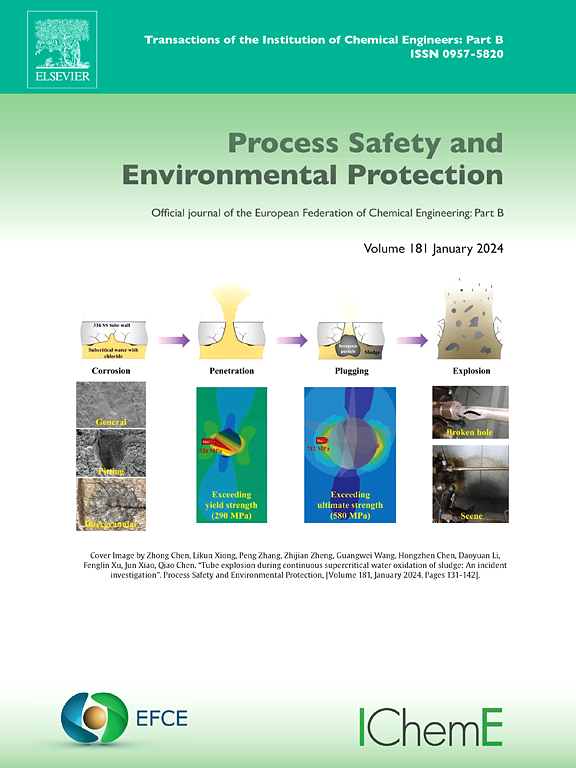A novel pretreatment process for vanadium extraction: Purification and recovery of negative component calcium in vanadium-bearing steel slag
IF 7.8
2区 环境科学与生态学
Q1 ENGINEERING, CHEMICAL
引用次数: 0
Abstract
According to the characteristics of vanadium-bearing steel slag, a novel pretreatment process for vanadium extraction was proposed to purify and recover the negative component calcium from vanadium-bearing steel slag. This process included three procedures: Selective calcium leaching – Rapid and efficient precipitation of calcium – Simple regeneration of calcium precipitation filtrate. The scientific law of the novel process was studied systematically. The results showed that under the optimum process parameters, the leaching efficiency of calcium could reach 63.1 %, while the other components were not leached. When the dosage ratio of precipitant (NH4)2CO3 was 1.2, the precipitation efficiency of Ca2 + was nearly 100 %, and high-purity calcium carbonate could be obtained. When the pH of the calcium precipitated filtrate was adjusted to 4 first and then adjusted back to 6.4, the calcium precipitation filtrate could be simply regenerated, which had a green and saving effect. Moreover, the analysis and calculation of the ternary phase diagrams of the Ca3SiO5-H2O-NH4Cl under different temperatures were performed, confirming that increasing temperature could promote calcium leaching reaction, and a stable product area could be formed through ammonium chloride reacting with tricalcium silicate. Meanwhile, the evolution of phases before and after calcium leaching was investigated via XRD and SEM-EDS, showing that the selective calcium leaching was essentially the destruction and disappearance of the calcium silicate phase, while the vanadium phase was exposed after calcium leaching, thus facilitating the subsequent vanadium leaching. Further, the effects of the novel process on subsequent acid-leaching vanadium were researched. The results indicated that after the novel process was used to pretreat vanadium-bearing steel slag, the leaching index and acid consumption of the subsequent vanadium leaching process were significantly increased and decreased, respectively. At the same time, the feed grade of acid-leaching vanadium was improved, the discharge of vanadium extraction tailings was reduced, and the production of acid-leaching solution with high acid and many impurities was avoided, thus the green and efficient vanadium extraction was realized effectively.
提钒前处理新工艺——含钒钢渣中负组分钙的提纯与回收
针对含钒钢渣的特点,提出了一种新的提钒预处理工艺,以提纯和回收含钒钢渣中的负组分钙。该工艺包括三个步骤:选择性钙浸出-快速高效的钙沉淀-钙沉淀滤液的简单再生。系统地研究了新工艺的科学规律。结果表明:在最佳工艺参数下,钙的浸出率可达63.1 %,其余组分均未浸出。当沉淀剂(NH4)2CO3的投加比为1.2时,Ca2 +的沉淀效率接近100 %,可获得高纯碳酸钙。先将钙沉淀滤液的pH调至4,再调回6.4,钙沉淀滤液可简单再生,具有绿色环保、节能的效果。并对不同温度下Ca3SiO5-H2O-NH4Cl的三元相图进行了分析计算,证实了温度升高可以促进钙浸出反应,氯化铵与硅酸三钙反应可以形成稳定的生成区。同时,通过XRD和SEM-EDS分析了钙浸出前后的物相演变,发现选择性钙浸出本质上是硅酸钙相的破坏和消失,而钒相在钙浸出后暴露出来,有利于后续的钒浸出。进一步研究了新工艺对后续酸浸钒的影响。结果表明,采用新工艺预处理含钒钢渣后,后续钒浸出工艺的浸出指数和酸耗分别显著提高和降低。同时,提高了酸浸钒的进料品位,减少了提钒尾矿的排放,避免了高酸多杂质的酸浸液的产生,有效地实现了绿色高效提钒。
本文章由计算机程序翻译,如有差异,请以英文原文为准。
求助全文
约1分钟内获得全文
求助全文
来源期刊

Process Safety and Environmental Protection
环境科学-工程:化工
CiteScore
11.40
自引率
15.40%
发文量
929
审稿时长
8.0 months
期刊介绍:
The Process Safety and Environmental Protection (PSEP) journal is a leading international publication that focuses on the publication of high-quality, original research papers in the field of engineering, specifically those related to the safety of industrial processes and environmental protection. The journal encourages submissions that present new developments in safety and environmental aspects, particularly those that show how research findings can be applied in process engineering design and practice.
PSEP is particularly interested in research that brings fresh perspectives to established engineering principles, identifies unsolved problems, or suggests directions for future research. The journal also values contributions that push the boundaries of traditional engineering and welcomes multidisciplinary papers.
PSEP's articles are abstracted and indexed by a range of databases and services, which helps to ensure that the journal's research is accessible and recognized in the academic and professional communities. These databases include ANTE, Chemical Abstracts, Chemical Hazards in Industry, Current Contents, Elsevier Engineering Information database, Pascal Francis, Web of Science, Scopus, Engineering Information Database EnCompass LIT (Elsevier), and INSPEC. This wide coverage facilitates the dissemination of the journal's content to a global audience interested in process safety and environmental engineering.
 求助内容:
求助内容: 应助结果提醒方式:
应助结果提醒方式:


